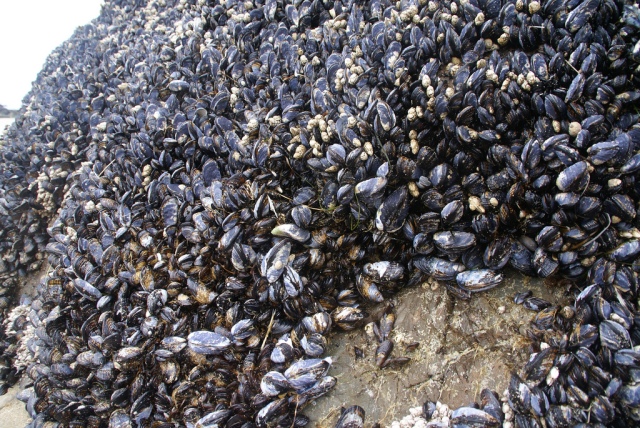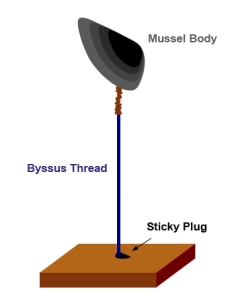 Despite the ease with which mussels can be cooked and eaten with chips, harvesting these tiny shelled bivalves from the seashore requires a certain amount of industrious prising.
Despite the ease with which mussels can be cooked and eaten with chips, harvesting these tiny shelled bivalves from the seashore requires a certain amount of industrious prising.
That’s because mussels use multiple thin byssus threads to securely fasten themselves to different surfaces along the coastline. These threads have a sticky plug at one end, with the mussel’s body dangling off the other (shown below).
 Scientists have found it difficult to explain how mussels tolerate the forces generated by constantly crashing waves and strong sea currents, since the calculated strength of the byssus threads alone is too low to withstand them.
Scientists have found it difficult to explain how mussels tolerate the forces generated by constantly crashing waves and strong sea currents, since the calculated strength of the byssus threads alone is too low to withstand them.
So, how exactly do mussels manage to stay attached to a rocky coastline, or the hull of a fast-moving ship?
Researchers at MIT explored this question by collecting mussels from Boston harbour, and testing them under different conditions.
They found that byssus threads are not made up of the same material all the way through. Instead, the thread sports a mixture of soft and hard material that optimises its ability to resist impact forces.
The soft material nearer to the body of the mussel deforms as mechanical forces are applied, while the hard material closer to the sticky plug stays in a very relaxed state until substantial force is applied.
This geometric structure results in a 900% increase in the mussel’s ability to withstand repeated bashing by waves (dynamic strength) compared to its ability to resist constant pressure (static strength).
This arrangement also conspires to create the least amount of force at the junction between the mussel’s body and the byssus thread, minimising the likelihood of a horribly wrenching separation.
Other animals using this ingenious materials design include the mantis shrimp and certain ancient fish.
This research has wonderful implications for the bio-design of new materials that need to withstand significant push/pull forces, such as submarines, wind turbines and materials going into space.
Qin Z, & Buehler MJ (2013). Impact tolerance in mussel thread networks by heterogeneous material distribution. Nature communications, 4 PMID: 23880603




